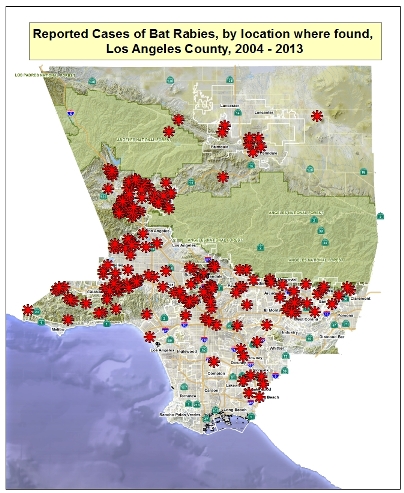 Bats and Rabies
Bats and Rabies
Bats are the species of animal that most commonly
carry rabies in Los Angeles County. However it is
important to know that most bats do not have
rabies! Most bats try to avoid contact with people and
pets. Bats are good for the environment because they eat
insects and pollinate plants. Bats are also protected by
state law.
Each red star on this map marks the
location where a sick bat was found by a resident,
reported to an animal control agency, and later tested
positive for rabies. Notice that rabid bats have
been found in most parts of Los Angeles County.
Rabid bats are likely also found in unpopulated areas,
but since these bats do not get reported (or tested),
they are not marked on the map.
Bats seen flying in daylight, or found
on the ground, are more likely to have rabies. Never
touch a bat or other wild animal. If you pick up a bat
with your bare hands, you may be bitten and exposed to rabies.
Bats that bite a person or pet should be tested
for rabies. The bite mark from a bat can be very small
and hard to see. Bats that are found indoors near a
sleeping person, young child, adult that cannot speak,
or pet should also be tested for rabies. In
these cases, try to gently trap the bat without touching
it (such as covering it with a bucket), and call your
local animal control agency. To see a list of local
animal control agencies,
click here. You
should also talk to your doctor and/or veterinarian in
these situations.
Links about rabies
Centers for Disease
Control - Rabies pages
Los Angeles County Department of Public Health
web pages
Local Rabies
Overview
Rabies
Control Manual
Human rabies
Read about rabid bats found in 2014! Click
here.
Last updated April 17, 2014